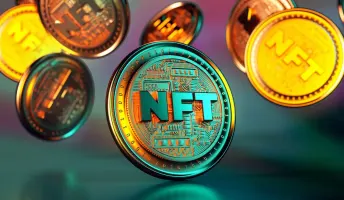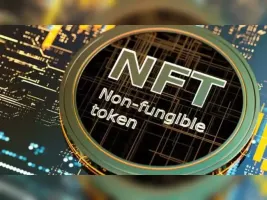Index
Introduction
INVEST IN THE FUTURE: NFTs OF DIGITAL ASSESTS
NFTs or NON- FUNGIBLE TOKEN is nothing but simply a digital owner or proof of a unique or non-exchangeable thing which we create ourselves. Which is cannot be copied by other, the ownership of a NFTs is recorded in the blockchain and can be transferred by the owner allowing NFTs to be sold and traded.
NFTs are generally created using the same type of programming used for cryptocurrencies but they cannot exchange or traded equivalently like cryptographic assets like bitcoin or Ethereum.
NFTs can represent digital or real-world items like artwork and real estate. “Tokenizing” these real-world tangible assets makes buying, selling, and trading them more efficient while reducing the probability of fraud. NFTs can represent individuals’ identities, property NFTs require the creation of digital tokens, through a technique called cryptography. In the crypto world, this token creation process is referred to as minting. Typically, to mint NFTs, you have to pay for creating smart contracts using cryptocurrency, and more.
NFTs work:
It's worked by Blockchain. It's nothing but a distributor database or, the power to update between participant of, public or private network computer. Blockchain store information on monetary transactions using cryptocurrencies but they also store other types of information such as product tracking. Blockchain are best known for their crucial role in cryptocurrencies system for maintaining a secure and decentralised record of transactions. Blockchain programming developers support the use of c++
NFTs or Non-Fungible Tokens are a kind of cryptocurrency that represents a one-of-a-kind digital asset or unique piece of artwork. Fiat and cryptocurrencies are mainly used for transactional purposes and are fungible, which means each unit can be interchanged.
NFTs can represent digital or real-world items like artwork and real estate. “Tokenizing” these real-world tangible assets makes buying, selling, and trading them more efficient while reducing the probability of fraud. NFTs can represent individuals’ identities, property rights, and more.
NFTs allow artists to establish ownership of their digital creations and ensure that they are not duplicated or passed off as someone else’s work. In addition to establishing authenticity, NFTs also provide a way to trace the ownership history of a particular digital asset.
FAMOUS NFTs:
1) A digital art by artist beeple and sold $69 million.
2) Ethereum – Based NYAN Cat meme art sold $600000(6 Lack Dollars)
3) Art replicator sold $4144400000
4) The artwork “The Merge” is an NFT sold for the outrageous sum of $ 91.8 Million via Nifty Gateway.
5) Human One” is the second most expensive artwork of Beeple, who is second in the ranking of artists with the highest NFT sales volume. Auctioned through Christie’s for $28.98 million.
6) Clock – sold $52 740 000.
7) CryptoPunk #7523 – sold $11 800 000.
8) Right-click and Save As guy is sold via SuperRare for 1,600 ether, so $7.09 million.
9) Ringers #109 – This piece of Art Blocks collection was sold for $6.93 million or 2,100 ether. This Art Block collection gathers a total of 99,000 NFTs.
10) Ross Ulbricht’s inaugural NFT named FreeRoss earned an astounding $6.12 million.
DIGITAL ASSESTS:
It is a data in binary format. A digital asset is anything that is stored digitally and is uniquely identifiable that organisation can used to realise value. digital assets include documents, pdf, photos, videos etc. binary format its nothing but binary language or a system language I.e., 0 &1
It has expanded to include investable asset type such as cryptocurrency NFTs, Assets- backed tokens, and tokenized realestate.
Digital assets are increasing in importance because they are becoming more a part of our professional and personal lives, while continuing to be essential for businesses and governments.
Perhaps the most well-known form of digital assets, cryptocurrencies, such as Bitcoin and Ethereum, are digital currency that are secured by cryptography via the blockchain. Cryptocurrency users can utilize these digital assets for numerous reasons, such as using them as a form of payment or investing in them.
The use of Digital Asset Management Software provides several benefits to businesses and helps to improve areas such as time management, employee productivity, asset accessibility, and team collaboration.
Digital assets create potential opportunities for new business from new asset classes and greater operational efficiency for asset managers. Exchanges can benefit from trading in new asset classes.
The access to a digital asset is stored in so-called crypto wallets, whereas the digital asset itself is stored on the blockchain.
INVEST IN THE FUTURE OF NFTs DIGITAL ASSESTS:

Two key investing principles assets allocation and diversification.
Investing in NFTs (Non-Fungible Tokens) can be an exciting but highly speculative venture. NFTs have gained popularity as a means of representing ownership of unique digital assets, such as artwork, collectibles, and virtual real estate. However, it's important to approach NFT investments with caution and conduct thorough research before making any financial commitments. Here are some considerations to keep in mind:
• Understand the market: Educate yourself about the NFT market, its trends, and potential risks. Stay informed about recent developments, emerging artists, and popular platforms for buying and selling NFTs.
• Conduct due diligence: Before investing in any NFT, thoroughly research the creator, the asset's history, and the underlying platform. Evaluate the reputation and credibility of the artist or brand associated with the NFT.
• Evaluate the uniqueness and utility: NFTs derive their value from their uniqueness and scarcity. Assess the quality and originality of the digital asset and consider whether it holds long-term value beyond the current hype. Additionally, evaluate if the NFT has any utility or functionality beyond being a collectible.
• Diversify your portfolio: As with any investment, diversification is key to managing risk. Instead of putting all your funds into a single NFT, consider spreading your investment across different assets, artists, and platforms. This strategy can help mitigate potential losses if one particular investment doesn't perform as expected.
• Beware of volatility and liquidity risks: The NFT market is highly volatile, with prices often fluctuating dramatically. Understand that the value of an NFT can decrease significantly, and there may not always be a liquid market for selling your assets quickly. Be prepared for potential price drops and illiquid market conditions.
• Consider long-term potential: While short-term speculation can yield profits, also consider the long-term potential of the digital asset and the artist associated with it. Artists with a strong track record and a genuine following are more likely to have sustainable value over time.
• Engage with the community: Join online communities, forums, and social media platforms dedicated to NFTs. Engaging with like-minded individuals can help you stay updated on the latest trends, discover new opportunities, and gain insights from experienced collectors and investors.
CONCLUSION:

NFTs have gained popularity as a means of representing ownership of unique digital items, such as artwork, music, videos, virtual real estate, and more. While some people have made significant profits by investing in NFTs, it's essential to remember that the market can be speculative and subject to rapid price fluctuations.
Always remember the golden rule of investing: never invest more than you can afford to lose. High potential returns also come with higher risk, so make sure your investment decisions align with your overall financial goals and risk profile.
